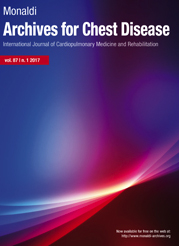Relationship between symptoms and results on spirometry in adults seen in non-tertiary public health facilities presenting with preserved ratio impaired spirometry
All claims expressed in this article are solely those of the authors and do not necessarily represent those of their affiliated organizations, or those of the publisher, the editors and the reviewers. Any product that may be evaluated in this article or claim that may be made by its manufacturer is not guaranteed or endorsed by the publisher.
Authors
Preserved ratio impaired spirometry (PRISm), defined by reduced forced expiratory volume in 1 second (FEV1) without meeting criteria for airway obstruction, is often encountered in clinical practice. The management of this heterogeneous condition in individuals with chronic respiratory symptoms is challenging, especially under limited diagnostic resources. Since 2020, all consecutive patients referred for spirometry at our institution have been invited to participate in our registry. Other than spirometry, no other physiological lung function testing is available in this public health service. Therefore, we reviewed our databank with the aim of assessing: i) the proportion of symptomatic patients aged 18 years or older referred for spirometry presenting with PRISm; ii) the rate of inhaled medication used in this group, suggesting a referral diagnosis of obstructive airway disease (OAD); and iii) the relationship between symptoms and results on spirometry in PRISM compared to a group with obstruction matched by FEV1. To this end, the COPD Assessment Test (CAT) and the Asthma Control Test (ACT) were conjointly responded to by 1032 participants, irrespective of the clinical suspicion. We found that 22% had PRISM, of whom 200 were paired with obstruction by FEV1 (68±10% of predicted). The CAT and ACT results were well-correlated in both groups (r=-0.727 and -0,698, respectively; p<0.001) and used to measure symptoms. Participants in the final sample (n=400) were aged 62±13 years; 70% were ever smokers; and 55% reported household exposure to biomass smoke (at least 5 years). The CAT responses were in the range of moderate symptoms (17±9) and ACT borderline for uncontrolled symptoms (19±5). The main differences were higher body mass index (33±7 versus 29±7 kg/m2; p<0.001) and proportion of females (72 versus 49%; p<0.001) in PRISm compared to obstruction. This group had lower exposure to tobacco (65 versus 76% of ever-smokers) but greater exposure to biomass smoke (61 versus 49%) (p<0.05 for all). The rate of inhaled medication use was as high in PRISm as in obstruction (80%). Notwithstanding matched FEV1, we found less prominent signs of airway disease in PRISM: marginally reduced FEV1/forced vital capacity (FVC) ratio (94±8% of predicted); higher expiratory flow between 25% and 75% of vital capacity, despite presumed lower lung volumes (lower FVC); and lower rate of bronchial hyperresponsiveness. In an identical multivariate model, FEV1 predicted symptoms of obstruction only. In conclusion, these data raise suspicion of a substantial rate of misclassification of individuals with PRISM as having OAD in healthcare facilities with constraints on diagnostic resources.
Edited by
The study protocol was approved by the Ethical Review Committee of the Jundiai Medical School (number 2.198.023).How to Cite

This work is licensed under a Creative Commons Attribution-NonCommercial 4.0 International License.






